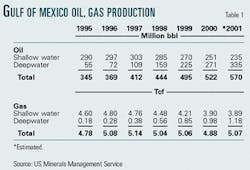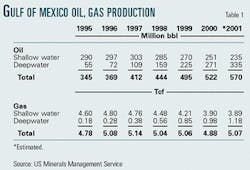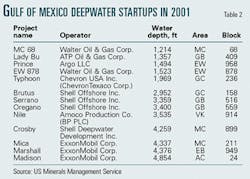Gulf of Mexico deepwater oil production hits record level
US Gulf of Mexico deepwater production again hit record levels last year, with an estimated 335 million bbl of oil and 1.18 tcf of gas, said officials of the US Minerals Management Service.
Oil production was up from 271 million bbl the previous year (Table 1).
"The rise in oil production from the deepwater Gulf of Mexico has continued at a phenomenal pace, with a 24% increase from 2000 to 2001," said MMS Regional Director Chris Oynes.
An estimated 570 million bbl of oil was produced in 2001 from all of the Gulf of Mexico, up from 522 million bbl in 2000.
"Natural gas production in the gulf showed a small increase, to an estimated 5.07 tcf in 2001," said Oynes. But deepwater gas production continued its rapid expansion, up 20% from 980 bcf in 2000. However, production from the gulf's more gas-prone shallow waters continued to decline. "It was about 2% lower in 2001 than 2000 and has declined 19% since 1996," Oynes said.
MMS officials said their estimates of last year's oil and gas production from the gulf are more tentative than in previous years, because actual production records are available only through May 2001. Production for the rest of the year was either estimated for shallow water or collected through a survey of deepwater operators.
Startups
There were production startups from 13 deepwater projects in the US sector of the gulf last year (Table 2).
MMS, under the US Department of the Interior, manages oil, natural gas, and other mineral resources on the US Outer Continental Shelf. Revenue that it collected from mineral leases on federal and Indian lands totaled nearly $10 billion in 2001 and more than $120 billion since the agency was created in 1982.
Nearly $1 billion/year of that revenue goes into the Land and Water Conservation Fund for the acquisition and development of state and federal park and recreation lands.


